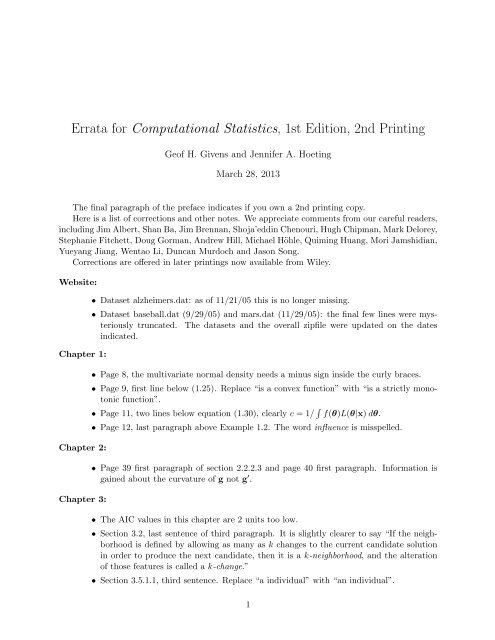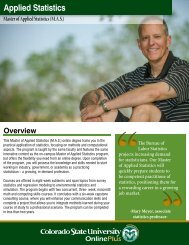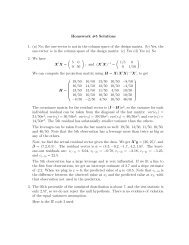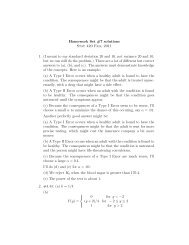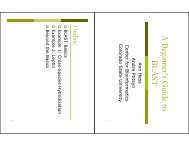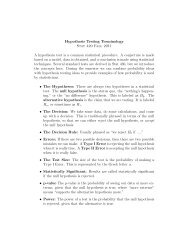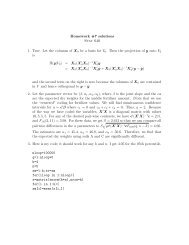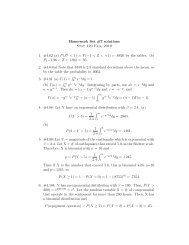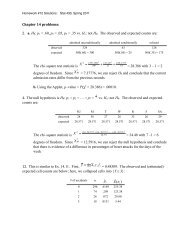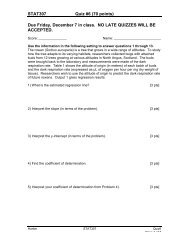Errata for Computational Statistics, 1st Edition, 2nd Printing
Errata for Computational Statistics, 1st Edition, 2nd Printing
Errata for Computational Statistics, 1st Edition, 2nd Printing
Create successful ePaper yourself
Turn your PDF publications into a flip-book with our unique Google optimized e-Paper software.
<strong>Errata</strong> <strong>for</strong> <strong>Computational</strong> <strong>Statistics</strong>, <strong>1st</strong> <strong>Edition</strong>, <strong>2nd</strong> <strong>Printing</strong><br />
Geof H. Givens and Jennifer A. Hoeting<br />
March 28, 2013<br />
The final paragraph of the preface indicates if you own a <strong>2nd</strong> printing copy.<br />
Here is a list of corrections and other notes. We appreciate comments from our careful readers,<br />
includingJimAlbert, ShanBa, JimBrennan, Shoja’eddinChenouri, HughChipman, MarkDelorey,<br />
Stephanie Fitchett, Doug Gorman, Andrew Hill, Michael Höhle, Quiming Huang, Mori Jamshidian,<br />
Yueyang Jiang, Wentao Li, Duncan Murdoch and Jason Song.<br />
Corrections are offered in later printings now available from Wiley.<br />
Website:<br />
Chapter 1:<br />
Chapter 2:<br />
Chapter 3:<br />
• Dataset alzheimers.dat: as of 11/21/05 this is no longer missing.<br />
• Dataset baseball.dat (9/29/05) and mars.dat (11/29/05): the final few lines were mysteriously<br />
truncated. The datasets and the overall zipfile were updated on the dates<br />
indicated.<br />
• Page 8, the multivariate normal density needs a minus sign inside the curly braces.<br />
• Page 9, first line below (1.25). Replace “is a convex function” with “is a strictly monotonic<br />
function”.<br />
• Page 11, two lines below equation (1.30), clearly c = 1/ ∫ f(θ)L(θ|x)dθ.<br />
• Page 12, last paragraph above Example 1.2. The word influence is misspelled.<br />
• Page 39 first paragraph of section 2.2.2.3 and page 40 first paragraph. In<strong>for</strong>mation is<br />
gained about the curvature of g not g ′ .<br />
• The AIC values in this chapter are 2 units too low.<br />
• Section 3.2, last sentence of third paragraph. It is slightly clearer to say “If the neighborhood<br />
is defined by allowing as many as k changes to the current candidate solution<br />
in order to produce the next candidate, then it is a k-neighborhood, and the alteration<br />
of those features is called a k-change.”<br />
• Section 3.5.1.1, third sentence. Replace “a individual” with “an individual”.<br />
1
Chapter 4:<br />
Chapter 6:<br />
• Page 76, Figure 3.6: graphical convention would normally have the vertical arrow pointing<br />
up, in the direction of increasing fitness.<br />
• Section 3.5.2.2, last sentence of third paragraph. Replace “Such an...” with “Such a...”<br />
• Exercise 3.4. The steady state GA should have G = 1/P.<br />
• Page 95, the first equation below (4.18), there is a log missing in the last term on<br />
the right hand side. In other words, the correct equation is E{logf X (x|θ)|x,θ (t) } =<br />
E{logf Y (y|θ)|x,θ (t) }−E{logf Z|X (z|x,θ)|x,θ (t) }<br />
• Page 98, fifth line up from the bottom of example 4.4, the end of the line should be p C<br />
,<br />
not p c .<br />
• Section 4.2.3. We have received the following email from Mori Jamshidian expressing<br />
his view of the SEM algorithm.<br />
I’m using your text <strong>for</strong> my computational stats class, and it’s been very good,<br />
especiallyintermsofthetopicscovered. WhencoveringChapter4, Section4.2.3<br />
on EM variance estimation, I noticed that you cover SEM algorithm as one of<br />
the main algorithms <strong>for</strong> EM standard error estimation. In a paper that you have<br />
also cited in your book (Jamshidian and Jennrich 2000, JRSS-B) we have noted<br />
that SEM does not have a solid theoretical foundation, and have explained why<br />
it’s prone to all sorts of numerical inaccuracies. Thus, we recommend that the<br />
SEM method not be used at all. You mention the method in Jamshidian and<br />
Jennrich (2000) as a ”more sophisticated numerical differentiation strategy.”<br />
It turns out that implementation of the methods in Jamshidian and Jennrich<br />
(2000) are much simpler than that of SEM, and as we show in our paper they<br />
result in highly accurate results. In our view, SEM is a failed attempt in using<br />
numerical differentiation in the context of EM, as we explain in our paper. Just<br />
thought to bring it up, in case you may find this useful <strong>for</strong> your future editions<br />
of the book.<br />
• Page 102, third line of example 4.6 should be ̂p T<br />
= 0.0132 not 0.132.<br />
• Page 104, equation (4.49): Omit the δ i from the denominator of this expression.<br />
• Page 104, the line above equation (4.51) should begin “<strong>for</strong> k = 1,...,C”.<br />
• Page 112, the line above equation (4.78) should begin “Finally, note that b (t) ,...”.<br />
• Page 150, example 6.2. Replace logλ ∼ N(4,0.5 2 ) with logλ ∼ N(log4,0.5 2 ).<br />
• Page 171, the sentence on lines 5–6 should read “Hence, h 2 (1 − U i1 ,...,1 − U im ) =<br />
h 1 (F1 −1 (1−U i1 ),...,Fm −1 (1−U im )) is monotone in each argument and has the...”.<br />
• Page 178, problem 6.3. There is a portion missing here. Part (a 1 2<br />
) is: Repeat the<br />
estimation using rejection sampling. Then the last line of part (b) should read “...to<br />
the output obtained in part (a 1 2 )” and part (c) should ask you to compare (a1 2<br />
) to (b).<br />
2
Chapter 8:<br />
Chapter 9:<br />
Chapter 11:<br />
Chapter 12:<br />
• Page 224, paragraph 2, line 5 “parameters” is misspelled.<br />
• Page 232, ( step 2, line 2 should read “...and run each chain...”, and line 4 should read<br />
X (0)<br />
k<br />
= q X (−1)<br />
k<br />
,U<br />
).<br />
(0)<br />
• page 232, step 3, third line from end replace “much” with “must”.<br />
• pge 237, equation (8.17), there should be a minus sign directly preceding the summation<br />
symbol.<br />
• In the first bullet of exercise 8.5, the matrix should be 22×22, not 42×42.<br />
• Section 9.2.4, last sentence of first paragraph. The bootstrap estimate of the bias is<br />
∑ B<br />
i=1 (̂θ ∗ i − ̂θ)/B = θ ∗ − ̂θ.<br />
• Page 271, bottom paragraph. Delete the sentence beginning “For two-sided intervals...”<br />
and the clause after the colon in the subsequent sentence. The improvement offered by<br />
the nested bootstrap depends on the accuracy of the original interval and the type of<br />
interval. In general, nested bootstrapping can reduce the rate of convergence of coverage<br />
probabilities by an additional multiple of n −1/2 or n −1 . See the cited references.<br />
• Page 336-7, Figure 11.13: The line types don’t match the text or the previous figure.<br />
We’ll fix the figure in the third printing, but <strong>for</strong> now, the caption and the third line on<br />
page 337 should indicate j = 1, h 1 = 0.05n (solid); j = 2, h 2 = 0.2n (dotted); and j = 3,<br />
h 3 = 0.5n (dashed).<br />
• Page 337, fourth line from the bottom should read “Y ∗ = Ŷ +e∗ ”.<br />
• Page 366, item 3, two instances of “training-set” should be replaced by “validation-set”.<br />
3


